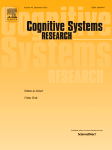Our next E-Intentionality seminar is this Thur sday, December 1st, at 13:00 in Freeman
sday, December 1st, at 13:00 in Freeman
G22. This will be a dry run of a talk I’ll be giving
as part of EUCognition2016, entitled “Architectural Requirements for Consciousness”. You can read the abstract here, along with an extended clarificatory discussion prompted by David Booth’s comments.
Monthly Archives: November 2016
Ethically designing robots without designing ethical robots
 Next Thursday, November 17th, at 13:00 I’ll be leading the E-Intentionality seminar in Freeman G22. I’ll be using this seminar as a dry run for the first part of my keynote lecture at the UAE Social Robotics meeting next week. It builds on work that I first presented at Tufts in 2014.
Next Thursday, November 17th, at 13:00 I’ll be leading the E-Intentionality seminar in Freeman G22. I’ll be using this seminar as a dry run for the first part of my keynote lecture at the UAE Social Robotics meeting next week. It builds on work that I first presented at Tufts in 2014.
Abstract:
Since robots will not, in the near future, be responsible agents, avoiding some moral hazards (e.g., that of abdication of responsibility) will require designs that assist in tracing complex lines of responsibility backwards from outcomes, through the robot, and back to the appropriate humans and/or social institutions. I look at one approach to ethically designing robots, that of designing ethical robots – robots that are given a set of rules that are intended to encode an ethical system, and which are to be applied by the robot in the generation of its behaviour. I argue that this approach will in many cases obfuscate, rather than clarify, the lines of responsibility involved (resulting in “moral murk”), and can lead to ethically adverse situations. After giving an example of such cases, I offer an alternative approach to ethical design of robots, one that does not presuppose that notions of obligation and permission apply to the robot in question, thereby avoiding the problems of moral murk and ethical adversity.
CFP: Cognitive Robot Architectures
Recently I was appointed to the Editorial Board of the journal Cognitive Systems Research. We have just announced a call for submissions to a special issue that I am co-editing along with the other  organisers of EUCognition2016. Although we expect some authors of papers for that meeting to submit their papers for inclusion in this special issue, this is an open call: one need not attend EUCognition2016 to submit something for inclusion in the special issue. The call, reproduced below, can also be found at:
organisers of EUCognition2016. Although we expect some authors of papers for that meeting to submit their papers for inclusion in this special issue, this is an open call: one need not attend EUCognition2016 to submit something for inclusion in the special issue. The call, reproduced below, can also be found at:
Special Issue on Cognitive Robot Architectures
Research into cognitive systems is distinct from artificial intelligence in general in that it seeks to design complete artificial systems in ways that are informed by, or that attempt to explain, biological cognition. The emphasis is on systems that are autonomous, robust, flexible and self-improving in pursuing their goals in real environments. This special issue of Cognitive Systems Research will feature recent work in this area that is pitched at the level of the cognitive architecture of such designs and systems. Cognitive architectures are the underlying, relatively invariant structural and functional constraints that make possible cognitive processes such as perception, action, reasoning, learning and planning. In particular, this issue will focus on cognitive architectures for robots that are designed either using insights from natural cognition, or to help explain natural cognition, or both.
Papers included in this issue will address such questions/debates as:
Continue reading
Move Over, Truth: An Instrumental Metaphysics
The next E-Intentionality seminar will be 13:00-13:50 Thursday, November 10th 2016 in room Freeman G22 (not G31 like all the EI/CogPhi meetings so far this term). Simon McGregor will present his research:
Move Over, Truth: An Instrumental Metaphysics
Most analytic philosophers are wedded to a realist metaphysics in which what matters is the truth or otherwise of philosophical assertions. I will argue for an utterly different metaphysical mode of thought, which focuses on reflective cognitive practice in the context of one’s lived concerns. This perspective understands rationality in terms of experienced instrumental justification, even for cognitive practices such as forming truth judgements.
Architectural Requirements for Consciousness
I’ll be giving a talk at the EUCog2016 conference in Vienna this December, presenting joint work with Aaron Sloman. Here is the extended abstract:
Architectural requirements for consciousness
Ron Chrisley and Aaron Sloman
This paper develops the virtual machine architecture approach to explaining certain features of consciousness first proposed in (Sloman and Chrisley 2003) and elaborated in (Chrisley and Sloman 2016), in which the particular qualitative aspects of experiences (qualia) are identified as being particular kinds of properties of components of virtual machine states of a cognitive architecture. Specifically, they are those properties of components of virtual machine states of agent A that make A prone to believe:
- That A is in a state S, the aspects of which are knowable by A directly, without further evidence (immediacy);
- That A’s knowledge of these aspects is of a kind such that only A could have such knowledge of those aspects (privacy);
- That these states have these aspects intrinsically, not by virtue of, e.g., their functional role (intrinsicness);
- That these aspects of S cannot be completely communicated to an agent that is not A (ineffability).
A crucial component of the explanation, which we call the Virtual Machine Functionalism (VMF) account of qualia, is that the propositions 1-4 need not be true in order for qualia to make A prone to believe those propositions. In fact, it is arguble that nothing could possibly render all of 1-4 true simultaneously. But this would not imply that there are no qualia, since qualia only require that agents that have them be prone to believe 1-4.
It is an open empirical question whether, in some or all humans, the properties underlying the dispositions to believe 1-4 have a unified structure that would render reference to them a useful move in providing a causal explanation of such beliefs. Thus, according to the VMF account of qualia, it is an open empirical question whether qualia exist in any given human. By the same token, however, it is an open engineering question whether, independently of the human case, it is possible or feasible to design an artificial system that a) is also prone to believe 1-4 and b) is so disposed because of a unified structure. This talk will: a) look at the requirements that must be in place for a system to believe 1-4, and b) sketch a design in which the propensities to believe 1-4 can be traced to a unified virtual machine structure, underwriting talk of such a system having qualia.
a) General requirements for believing 1-4:
These include those for being a system that can be said to have beliefs and propensities to believe. Further, having the propensities to believe 1-4 requires the possibility of having beliefs about oneself, one’s knowledge, possibility/impossibility, and other minds. At a minimum, such constraints require a cognitive architecture with reactive, deliberative and meta-management components (Anonymous1 and Anonymous2 2003), with at least two layers of meta-cognition: (i) detection and use of various states of internal VM components; and (ii) holding beliefs/theories about those components.
b) A qualia-supporting design:
- A propensity to believe in immediacy (1) can be explained in part as the result of the meta-management layer of a deliberating/justifying but resource- bounded architecture needing a basis for terminating deliberation/justification in a way that doesn’t itself prompt further deliberation or justification.
- A propensity to believe in privacy (2) can be explained in part as the result of a propensity to believe in immediacy (1), along with a policy of *normally* conceiving of the beliefs of others as making evidential and justificatory impact on one’s own beliefs. To permit the termination of deliberation and justification, some means must be found to discount, at some point, the relevance of others’ beliefs, and privacy provides prima facie rational grounds for doing this.
- A propensity to believe in intrinsicness (3) can also be explained in part as the result of a propensity to believe in immediacy, since states having the relevant aspects non-intrinsically (i.e., by virtue of relational or systemic facts) would be difficult to rectify with the belief that one’s knowledge of these aspects does not require any (further) evidence.
- An account of a propensity to believe in ineffability (4) requires some nuance, since unlike 1-3, 4 is in a sense true, given the causally indexical nature of some virtual machine states and their properties, as explained in (Anonymous2 and Anonymous1 2016). However, properly appreciating the truth of 4 requires philosophical sophistication, and so its truth alone cannot explain the conceptually primitive propensity to believe it; some alternative explanations will be offered.
References:
Sloman, A. and Chrisley, R. (2003) “Virtual Machines and Consciousness”. Journal of Consciousness Studies 10 (4-5), 133-172.
Chrisley, R. and Sloman, A. (2016, in press) “Functionalism, Revisionism and Qualia”. APA Newsletter on Philosophy and Computers 16 (1).
